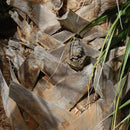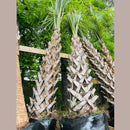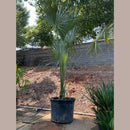| Grows Well In Zones: | 8-11 Outdoors |
| Mature Height: | 20-25 ft |
| Mature Width: | 8-10 ft |
| Sunlight: | Full Sun to Partial Shade |
| Growth Rate: | Moderate |
| Shape: | Tree |
| Placement: | Outdoors |
Majestic Tropical Enchantress
The Sabal Palmetto Palm Tree, a majestic palm native to coastal regions, stands tall and strong with its tropical crown of fan-shaped fronds. It is a robust palm tree with a thick trunk that can grow over 40 feet tall, with an imposing canopy of dark fan-shaped fronds.
Sabal Palmettos are cold-hardy down to 20°F, with short drops to 10°F, extremely drought tolerant, salt-tolerant and resistant to pests and diseases. Its low-maintenance requirements make it an easy palm to care for. Sabals are also wind-tolerant, known to survive winds of more than 100 miles per hour.
The Sabal Palmetto is also known as the Cabbage Palm. It earns its name from the edible portion in the heart of this palm, commonly known as the heart of palm or swamp cabbage, and is considered a culinary delicacy.
Sabal Palmettos can be styled as booted or slick trunks. Booted Sabals are natural palms that have their “bootjacks” or remaining bases from old fronds that have fallen off. This gives the palm a textured, thick look. Slick Sabals have the spiky boots shaved off, giving them a cleaner, more elongated look.
Sabal Palmettos look beautiful when used as a landscape specimen, accent tree, or planted in groups of staggering heights. They make great tropical accent palms in pool areas.
Q: How tall do Sabal Palmettos get?
A: In the wild, they can grow 50 to 60 feet tall. The thick canopy filled with green fan-shaped fronds can spread 10 to 15 ft wide.
Q: Are Sabal Palms cold-hardy?
A: Sabal Palmettos are cold-hardy, withstanding sustained temperatures down to 20°F with short drops to 10°F.
Q: How fast do Sabal Palmettos grow?
A: Sabal Palmettos grow 12-24 inches per year.
1. Sunlight
Sabal Palmettos prefer full sun, but they tolerate locations with partial sunlight as well.
2. Water
- For the first month, water twice a week. After it is established, water once a week unless it rains.
- Watering needs to be thorough to make sure the bottom roots receive water at every watering.
- Space out watering sessions so the roots are able to dry.
- The amount of water needed per palm per watering session is equivalent to the volume of the planting hole that was dug for each palm. This amount may range from 2 gallons for small containerized material to 15 gallons for larger palms.
- Plants in a container need more constant watering than those planted on the ground.
- Overwatering or bad drainage can cause permanent damage to the roots over time.
- Placing mulch over the roots can help with water retention. Use caution not to allow the mulch to touch the base of the palm, otherwise it can cause rot.
Seasonal watering changes
Depending on your geographic location and the intensity of the season, you may need to adjust watering accordingly:
Winter: (60 degrees or less) no need to water, except for the first 30 days after installation.
Spring: (75 degrees or less) Once a week.
Beginning of Summer: (90 degrees or less) Twice a week.
Heat of Summer: (90 degrees and above) Three times a week.
3. Fertilization
Sabal Palmettos should be fertilized three times a year in the Spring, Summer and Fall. Use a general purpose blend specific to palms, and be sure to follow the instructions on the label.
4. Soil
Sabal Palms tolerate most soils, as long as they drain well. To improve drainage combine 70% soil with 30% coarse sand.
5. Pruning
It is not necessary to prune your Sabal Palmetto. When a frond dies, it will detach and fall off on its own. However, if you decide to prune the brown frond before it naturally falls off, be careful not to do so when there is still some green color remaining in the frond.
6. Winter Care
If temperatures fall below 10° F, wrap trunk with thick blanket and if possible, wrap incandescent lights around the blanket for added heat.
Customer Reviews
Payment & Security
Your payment information is processed securely. We do not store credit card details nor have access to your credit card information.





































